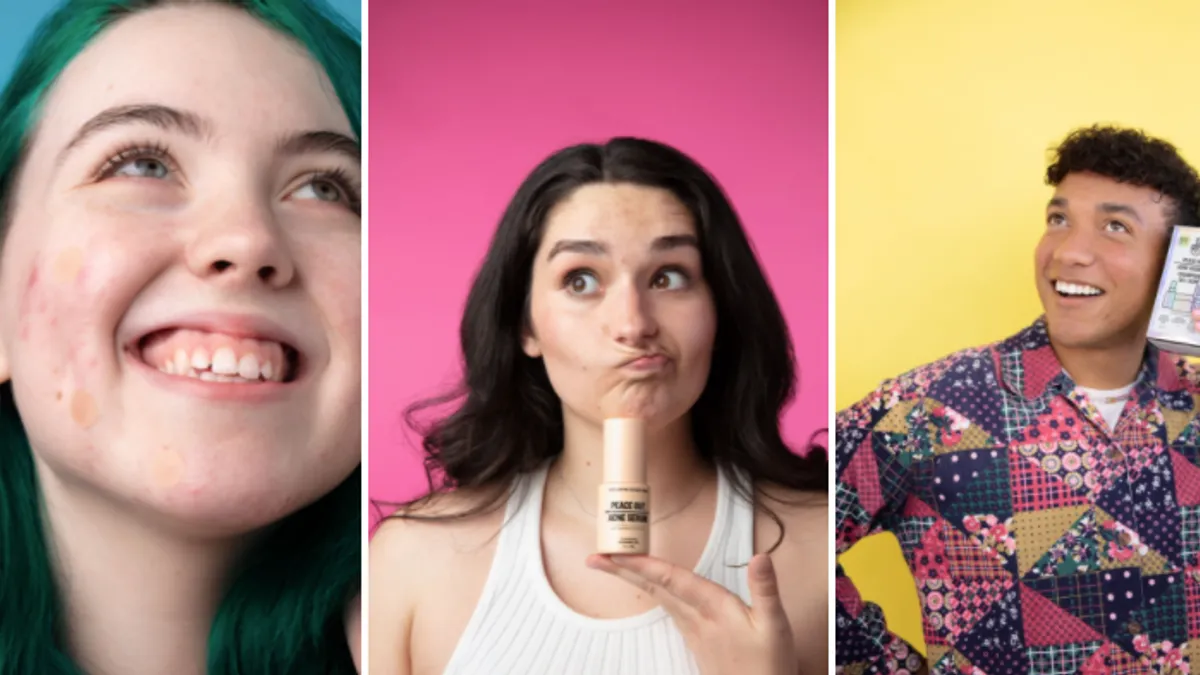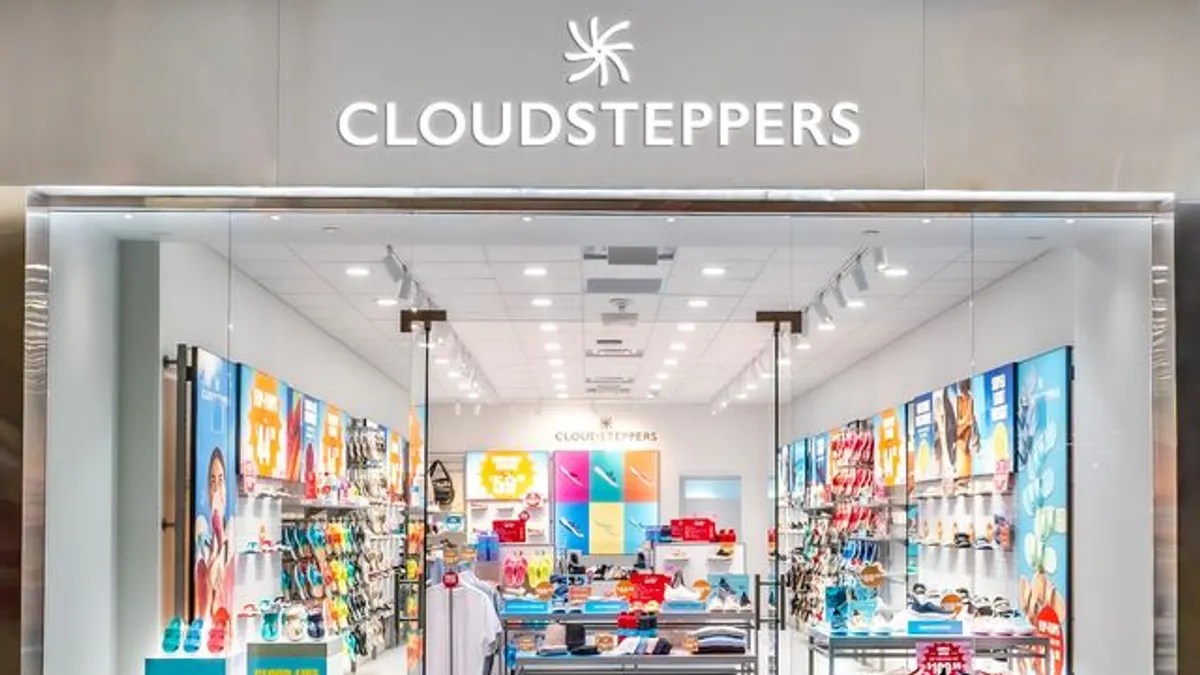Make-up free with unkempt hair, influencers regularly appear on Peace Out's TikTok page like they're in the middle of their nighttime routine, putting on or removing a pimple patch inches away from a camera
Having skin-positive conversations with Peace Out's products have gained popularity on TikTok. Peace Out's videos can reach up to 500,000 views, sometimes more, and videos with #peaceoutskincare on TikTok have about 9.7 million views total.
"The conversation was always, you're not attractive if you have acne, you're not attractive or worthy if you have acne. The only way to make you become worthy or attractive is to get rid of your acne, and then you could be a fully-functioning person," said Junior Pence, chief marketing officer of Peace Out Skincare. "When we started the brand, [our founder] was very specific in making sure everything we did spoke about acne in a positive way."
The advertising method, though untraditional, is the company's attempt to flip the script on what had historically been a negative conversation about acne, he said.
Peace Out, like many other direct-to-consumer brands, thrive in addressing topics and marketing products that were once perceived as taboo or even "gross," as Pence puts it. DTC brands have disrupted just about every industry from acne and periods to sex toys and toilet plungers.
"I think Gen Z really embraced the skin positivity movement in a way that we have not experienced before," Pence said. "People didn't want to be held back by their skin conditions. Instead, they wanted to share them and share them in fun, innovative, sometimes super gross, ways."
As shoppers become more adept at trying new things and the stigma around these products dwindles, a growing list of DTC brands are launching merchandise that consumers don't openly talk about.
@peaceoutskincare Hello there????????????????Can I get a pack of Peace Out Pores ASAP????????????????????#PeaceOutSkincare #Sephora #porestripreveal #pores #skincare #fyp
♬ Beach Bunny by Cloud 9 - Quinn
Poo-Pourri gained popularity for its quirky ads and simply for what it is — a toilet deodorizing spray. DTC brand Staff is making its name in the space by selling brightly colored toilet plungers. Maude, on the other hand, is a sexual wellness company aiming to redefine the industry with more inclusive products and minimal design.
"I think the demand has been there. And now, what these brands are realizing is that they can approach their consumers in a thoughtful way and in a way where they're utilizing candor, they're using a refreshing directness," said Ross Steinman, consumer behavior professor and co-chairperson of the psychology department at Widener University. "In the past, they might not have done that because, for whatever reason, their products and their marketing might have been viewed as offensive."
Consumers that don't keep things on the down-low
Consumers have undergone several consumption-based cultural shifts in recent years, which means they are far more outspoken and open to testing unconventional products, Steinman said.
When consumers spoke out against brands for issues like diversity and representation, DTC brands listened and filled the gap.
After years losing 7.7 points in market share between 2013 and 2018, per Coresight Research, Victoria's Secret began doing away with much of its hypersexualized marketing. Digitally native entrants in the category (like ThirdLove and Adore Me), that do a better job tapping into the body positivity movement, had contributed to the brand's decline, the report indicates.
Younger consumers, particularly Gen Z, are more conscious of social justice issues and whether the brands they spend money on align with their personal beliefs.
Generally speaking, consumers have also come to an understanding that they have certain needs — whether it be menstrual, toiletries or acne products — and there's no need for it to be "pushed under the covers," Steinman said.
"The more conversations we can have about these things, the greater the benefit to all of us as consumers," he said. "The reluctance of consumers to speak up about these things has hurt brands for years. So now if it's moved away from being something that should be hidden, taboo or not talked about, if it's more accepted and discussed, now that presents opportunities for brands to engage with the consumers and really learn more about what they want."
Just because brands are selling a product that is considered taboo does not make it less awkward to sell. When it comes to these categories, brands tend to use humor to soften the seriousness of the topic and deliver an emotional appeal, Steinman said.
"Humor obviously captures attention, but also humor, in terms of communication, should highlight a solution to the problem," he said. While leaning into lighthearted content can be an effective way to stand out among competitors, if brands could use it to educate consumers, "they're going to be building those memory nodes in terms of recalling that brand at a later date."
Still, being upfront and unapologetic about stigmatized topics doesn't always appeal to every consumer.
"For me, it's more like something to reflect on. The stigma is so deep that we think that this fundamental part of our body and a natural bodily function is gross."

Nadya Okamoto
Co-founder of August
Nadya Okamoto, co-founder of August, knows a thing or two about receiving negative feedback.
Ahead of its official launch of period products on Thursday, Okamoto's team at August — a Gen Z, community-focused period company aiming to reshape the stigma and shame around menstruations — often posted content on social media that put period blood on display. Okamoto said her team frequently receives comments and direct messages from consumers who felt like showing menstrual blood and talking about periods were "an invasion of privacy."
"For me, it's more like something to reflect on," she said. "The stigma is so deep that we think that this fundamental part of our body and a natural bodily function is gross."
Appealing to a demographic that she, her co-founder and many of her team members belong in makes it easier to produce content that's authentic, said Okamoto, 23. She said Gen Zers heavily push back against societal norms and companies that perpetuate negative stigmas around something as natural as having periods.
"It is much easier to honestly talk to a 10-year-old about periods and get them to a point where they feel comfortable with it, than someone who's been told for decades that periods are something that are such an inappropriate topic," she said. "I think that there is this hunger for being able to dismantle stigmas for younger people. At the same time, it's what we know."
Why taboo topics fit DTC's like a glove
Almost as soon as digitally native brands begin growing in numbers, they seem to be seeing success in reinventing categories that have traditionally been thought of as awkward.
Unlike smaller digital natives, selling unconventional products or expressing their stance on prevalent issues can be a touchy subject for some big-name brands. Because of their wider reach, name brands have a higher chance of communicating to the wrong audience, experts said.
Though brands may be hesitant to put their two cents on politics more than half of consumers, and 69% of Gen Z and millennials specifically, turn to social media to understand a brand’s stance on major issues, according to a 2020 study from Sprout Social. And when a brand’s values align with their own and are reflected in its social media presence, 58% of consumers purchase from that brand.
When brands shy away from social issues or avoid talking about a product that may be deemed controversial, brands lose sales, said Dave Marcotte, senior vice president at Kantar.
"Anytime you take a product off the shelf, anytime you take a product out of view, you're killing sales," he said. "A lot of what's occurred in the last couple of years has been a re-examination of, 'Why did you put it behind the counter?'"
And that's where advertising and selling highly specific products directly to consumers get a win, experts said.
Thanks to social media, DTC brands can be "highly surgical" in their messaging and the end buyer they're attempting to reach, said Matt Kleinschmit, CEO of Reach3 Insights.
"Because of the fact that they are direct to consumer, they're potentially smaller in nature," he said. "They tend to present themselves as being a bit quirky, in some respects, and frankly I think that consumers don't hold these brands at the same sort of standard as they would a huge multinational type of brand."
Presenting themselves as the opposite of what the mainstream market looks like works for some DTC brands, especially when they have smaller advertising budgets, in order to stand out against their competition, Kleinschmit said.
Digitally native brands banking on going social media viral are on to something. Consumers who connect with companies on social platforms tend to be more loyal, with nine out of 10 saying they make purchases from brands they follow on social media, a 2020 study from Sprout Social indicates.
Poo-Pourri's viral commercial six years ago amassed over 39 million views on YouTube for its quirky unicorn commercial. Meanwhile, women's razor brand Billie released a commercial in February last year showing underarm hair — an ad that racked up over 5 million views on YouTube.
"The target market of these brands, oftentimes, are looking for these organizations to be a little bit outside of the mainstream and a little different in nature than the mainstream mass brands that everyone uses," Kleinschmit said. "It's sort of a two-way street, so to speak, where the brands themselves are using some of these taboo topics and messaging to break through and cut through the clutter and their potential customers are also expecting these types of brands, that maybe aren't as well known, to go there."
When the shock value runs dry
Several DTC brands make use of their edginess to generate attention and appeal. But at some point in time, topics and products once considered refreshing and new can wither out.
"This notion of taboo is a moving target, and it changes over time for sure, and now it changes as you move across different segments of the population," said Christie Nordhielm, associate professor of marketing at Georgetown University. "It's not an easy thing to say where that line is at any point in time or for any particular set of people."
The DTC model of hyper-targeted advertising can quickly become an "echo chamber" once brands find their audience who react positively to their brand, she said. Marketing to the same group of consumers could potentially negatively impact the brand's long-term revenue, she said.
"You're preaching to the converted, and that pool of consumers is naturally going to be smaller, and there's no reason to anticipate that it's going to increase in size just from DTC efforts," said Nordhielm. "The only way to increase that pool is to go broad scale and to try to invite others to join."
But some mass marketing methods like broadcast advertising are heavily regulated by the Federal Communications Commission, and the rules can sometimes be ambiguous, said Nordhielm. Societal norms can be highly fragmented and polarizing, which makes it difficult to build communication that'll bring people together, she said.
By attempting to reach a new set of audiences, however, brands run the risk of alienating their existing ones, experts said. In this instance, DTC brands could end up losing their relatable appeal.
On the other hand, Peace Out's Pence considers authenticity as a necessary brand quality to survive in today's climate.
"We have always been product, solution, benefit-specific in our messaging," he said. "So there hasn't been a lot of fluff if you will."
Peace Out's core consumer group expects the brand to have an opinion on uncomfortable subjects, Pence said. He added that being a brand that isn't under the ownership of a conglomerate or a large company makes it easier for Peace Out to stick to its identity.
"We have a brand identity that we have to stand behind, and we do stand behind. And for us, there's no other option but to grow as society grows," he said. "I don't think that we'll ever not be that way."
Editor's note: This story was first published in our weekly newsletter, Retail Dive: DTC. Sign up here.























